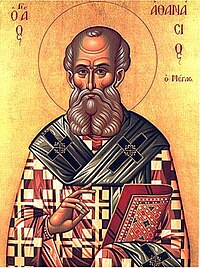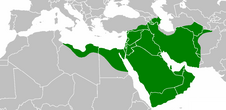Click here to return to 6) Ongoing Thread of Monotheism
Religious Tsunami
The Global Game-Changer
In the first century following
Muhammad’s
emigration to Medina in 622 CE,
Islam would become the largest empire in the history of the known world, expanding twenty percent further than Rome in 1/10 the time. At its height, Islam would extend from
India to the Atlantic Ocean, and include the
Near East,
Persia, portions of
Asia Minor and a swath of
North Africa more than three times the area of Roman Africa (map below).
This meteoric spread of “
The Prophet’s” faith was fueled by failed economies and depleted militaries of the
Byzantine and
Persian empires. Ironically,
polytheistic beliefs (
Hellenism and
Zoroastrianism) which had been traditionally interwoven with government functions were on the decline as well. Add to this list the
post-Nicene heretical persecutions of
Christians by fellow
Christians and Islam’s rapid growth appears to have been nurtured by fairly receptive conditions.
Seeds in Fertile Soil
Minimizing resistances was a persistent key to the spread of the Muslim empire. Centuries earlier, during the spread of monotheistic Christianity,
Pagan polytheism was then closely tied to a failing government. Christianity’s spread throughout the Roman Empire progressed as the empire’s
economic,
military and
polytheistic religion declined. Emperor
Constantine realized the value of uniting Christians within the military with his apparent conversion just before the game-changing
Battle of Milvian Bridge. Later he would turn to Christianity yet again to fortify his government by legalizing Christianity with his
Edict of Milan in 313 CE. Conversely, his personally initiated
Council of Nicaea in 325 CE would create considerable
fallout within the new church, which conquering Muslims would later capitalize on.
 |
| Bedouin Soldier |
Islam’s campaign formula was simple - move rapidly to overwhelm opposing forces, dissemble pagan beliefs and enforce Islam’s brand of monotheism with toleration for other forms of similar
Abrahamic monotheism (i.e.: Christianity, Judaism).
Unlike the Byzantine bishops, who were casting out
numerous Christian sects that didn’t abide by the dictates of the
Council of Nicaea (while initiating Jewish persecution), Muhammad expressed tolerance to differing Abrahamic beliefs. Western lore of Muslim insistence to “convert or die” simply wasn’t the case, at least not on Muhammad's watch. However, total compliance had been applied during Alexander the Great’s conquests, as well as those of the Roman Legions.
 |
| John the Baptist Shrine at Umayyad |
Once subject to Muslim domination, Jews and Christians sects were allowed to keep their faith. Muhammad even shared the Church of
Saint John the Baptist in Damascus (today's Umayyad Mosque) with the conquered local Christians, giving them full use of the church on Sundays.
Pagan idols and temples were destroyed, while Pagans and Christians were left to convert on their own. For Gnostic and similar disaffected Christians there really wasn’t much of a transition to make. They had been
rejected by Nicaea, and Islam shared similar beliefs
regarding the non-divinity of Christ. A Gnostic converting to Islam could still maintain a belief in
the Immaculate Conception and all the
works of Christ, including his miracles. Since most Gnostics believed Christ’s human form was not divine, Islam's description of
Christ as a miracle-working prophet offered a clear alternative. Once converted to Islam there would be the added benefit of greatly reduced, finger-wagging clergy.
Beginnings
A Prophet’s Calling
Muhammad had grown up an orphan amongst his
Bedouin brethren to become a well like, even charismatic adult. He had settled in
Mecca where he resided as a merchant and shepherd.
Once in 605 CE, after a fire had dislodged the sacred
Black Stone from its setting within the
Kaaba shrine, a dispute erupted between four prominent clan leaders over who would have the sacred honor of replacing the stone. All parties agreed the next person to enter the Kaaba should decide which of the clan leaders should have the privilege.
Muhammed, then 35 years old, was next to enter the Kaaba. Once asked, he suggested they together place the Black Stone upon a cloth and, with each of the four clans leaders taking a corner of the supporting cloth, carry the stone to its final encasement where they would jointly place the stone within its setting. The clan leaders were so impressed they unanimously agreed it should be Muhammad who should set the stone it into the final setting. Thus began Muhammed’s life as a community leader and tribal arbitrator.
Angle Gabriel’s Revelations
Either because of the
Christian monk Bahira’s (also known as Sergious or Syriac) revelation 30 years earlier, the
incident with the Black Stone, or both,
Muhammad eventually became preoccupied with daily prayer. As Muhammad approached 40, he
began retreats to a nearby cave on Mount Hira near Mecca, to meditate and pray. Islamic tradition holds that one day, in or about the year 610 CE, while meditating within that same cave, the angel
Gabriel appeared to him revealing sacred verses from what was to later become the Quran. Three years later Muhammad’ revelations resumed with orders to begin the teaching and conversion of Pagans to Islam.
Triumph over Polytheists
Once popular amongst the different clans residing in Mecca, Muhammad’s initial sermons
were not warmly received by most because of persistent pagan beliefs. Still his following would grow, even if slowly at first. As it did, the
taunts and criticisms of his adversaries turned to threats. For fear of reprisals, Muhammad and his followers
resettle in Medina in 622 CE. Today this emigration is
know by Muslims as “Hijra’ and marks the beginning of the Islamic calendar.
After migration, the Meccan tribes pursued Muhammad and his followers.
Eight years of conflict ensued. Muhammad’s persecution eventually began to gather sympathetic support and
his following would grown to over 10,000 strong. Eventually the tide would turn against those that opposed and persecuted. In 630 CE enemy forces were overcome by Muhammad and his followers who subsequently returned to Mecca as victors. As he
entered Mecca triumphantly he would set a precedent with benevolence. Traditionally, a conqueror would kill surviving males as potential combatants and sell the women and children into slavery. Muhammad did neither, he instead rode with followers to the Kaaba and destroyed all the pagan idols on display within.
Social Rejuvenation
It would be this declaration of altruism which would become the hallmark of all the prophet’s conquests. In many instances government officials were left in place so as not to disrupt business and everyday life.
Muslims would work and worship along side Jews and Christians (monotheistic,
Abrahamic beliefs). Moreover, the Muslims would share
scientific and engineering knowledge,
advancements in medicine and the expansion of
trade routes (introducing fine fabrics, amongst other goods). Technology innovations included building,
expansion and repair of aqueducts as well as innovative gravity-feed manmade water basins for water purification. Finally, the Muslims introduced detailed and
elaborate forms of artisanship as well as well as
architectural advancements that would eventually influence the
European Renaissance which followed immediately after the
Middle Ages and the
Crusades.
Subsequently, the
spread of Islam across a declining Roman Empire with failing infrastructure, accumulated debt, and an exhausted military is not to hard to imagine. The resulting religious, social and economic change resulted in minimal resistance and acceptance.
The Rashidun Caliphs
The
Rashidun ("Righteous") Caliphs is a Sunni phrase, directed at Shia Muslims and used to describe
the first four Caliphs (rulers) of the
Caliphate Polity to follow Muhammad. Opposing Shia views point to
Ali ibn Abi Talib, Muhammad's son-in-law (the fourth Caliph), as the first true successor. However, for the sake of brevity, this section will only cover Caliphs Abu Bakr and Umar. These first to Caliphs would together be responsible for the greatest expansion of Muslim territory. The third and fourth Caliphs,
Uthman and
Albi ibn Abi Talib, are mentioned as points of reference in the following section.
Abu Bakr
 |
| Abu Bakr |
After
Muhammad's demise in 632 CE,
Abu Bakr (Abu Bakr as-Șiddīq), his closest friend and collaborator, was made
Caliph of all Islam. Shortly thereafter, Abu Bakr was challenged by family members and other who knew Muhammad. They insisted
Ali ibn Abi Talib, a cousin and son-in-law to Muhammad, had been designated successor by Muhammad himself. However, for the purpose of tribal solidarity Abi Talib is said to have eventually accepted Abu Bakr as the new Muslim leader.
In 633 CE Abu Bakr launched an
invasion of the Sassanid Persian Empire to take Iraq. He would embrace and convert Arabs within the region to join his forces and supply details of garrisoned Persian forces. Rather than face overwhelming forces, Abu Bakr would instead split up his own forces to attack and destroy separate Persian garrisons before they could gather in force.
A key general in this offensive was
Khalid ibn al-Walid, also known as the
"Drawn Sword of God", a friend to the late Muhammad and a comrade in arms against the
Arab civil wars (Ridda Wars) that immediately followed
Muhammad's death. After
capturing Iraq (Mesopotamia) from Persia, Khalid was summoned by Caliph Abu Bakr to
assume command of Islamic forces postured to capture Roman Syria (which today consist of
Israel,
Palestine,
Jordan, Lebanon and portions of Southern Turkey). Khalid put his Beduin instincts to good use and decided to take a
shortcut through the Syrian Desert. Legend has it that his men marched for two days without water. He arrived in North Syria catching Byzantine forces off guard on their right flank and quickly defeated them, capturing all their border forts. Khalid then
moved to Bosra Syria and, after a small contingent force drew out the entire
Ghassanid garrison (
Christian Arabs forces), Khalid moved from behind to cut them off from retreat and defeated them. Khalid then moved on the Damascus where he emerged victorious after a lengthy siege, Defeating Byzantine
Emperor Heraclius' son-in-law Thomas,
who was killed by Khalid in a duel following the battle. Khalid magnanimously returned Thomas' wife to her father Emperor Heraclius.
After only a reign of two years
Abu Bakr fell ell and died. Before dying he named
Umar ibn Al-Khattāb, also known as
"Al-Faruq" or "the one who distinguishes between right and wrong", his successor, to avoid unrest within the clans and maintain the military presence he had fought so hard to secured.
Commentary
Under
Umar ibn al-Khattab, Islam grew at a phenomenal rate. Persia continued to fall and, to a good extent, most of eastern Byzantium. During his
ten years as Caliph, Umar would complete the
conquests of Syria, Palestine, Eastern Anatolia, Armenia, Egypt, Eastern North Africa, Iraq, Isfahan, Fars, Sistan, Azerbaijan, and Khurasan. During that time, Caliph Umar would see Bedouin forces through a
great famine, where his astute administrative abilities saved countless lives, and a
plague that devastated Islamic forces in Syria.
Aside from negotiating with the tribes after Muhammad’s death to
create the Caliphate, Umar had been instrumental in successfully nominating his predecessor,
Abu Bakr as the first Caliph. Umar was said to have
a tall and robust figure, a physique he developed as a wrestler in early years.
Umar would be
assassinated at prayer, in 644 CE, as the result of a Persian conspiracy. The assassin committed suicide shortly afterwards, using the same sword. While dying of his wounds, Umar appointed
a six-person committee to appoint his successor and maintain unity.
To Umar's credit, he was involved in the Islamic movement early on and was both friend and protector to Muhammed. Continuing where Abu Bakr left off,
Umar oversaw the conquest of more territory than any Islamic leader, and perpetuated the
Caliphate. Subsequently, he is today remembered as the
most influential leader in Islamic history.
Click here for 8) Comparing Islam and Christianity
Got Feedback?
Comments? Questions? Corrections? Any feedback at all? Just click on the comments box at the bottom of this page and enter your thoughts. All comments are welcome.
You might also be interested in...
Copyright ©2013 Tom Mallon. All rights reserved.

















No comments:
Post a Comment